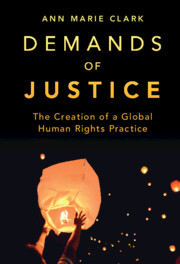Book contents
- Demands of Justice
- Demands of Justice
- Copyright page
- Dedication
- Epigraph
- Contents
- Figures
- Tables
- Preface
- Acknowledgments
- 1 Introduction
- 2 Human Rights and Justice in Global Politics
- 3 Human Rights Tools in the Pursuit of Justice
- 4 Expanding the Global Neighborhood
- 5 A Human Rights Culture of Argument
- 6 “Together for Rights”
- 7 Conclusion
- Bibliography
- Index
4 - Expanding the Global Neighborhood
Amnesty International’s Urgent Action
Published online by Cambridge University Press: 03 March 2022
- Demands of Justice
- Demands of Justice
- Copyright page
- Dedication
- Epigraph
- Contents
- Figures
- Tables
- Preface
- Acknowledgments
- 1 Introduction
- 2 Human Rights and Justice in Global Politics
- 3 Human Rights Tools in the Pursuit of Justice
- 4 Expanding the Global Neighborhood
- 5 A Human Rights Culture of Argument
- 6 “Together for Rights”
- 7 Conclusion
- Bibliography
- Index
Summary
Incorporates first-person interviews with people who invented and implemented Amnesty International’s Urgent Action approach to demonstrate how early human rights advocacy implemented three tools of the justice of neighborhood - active care, habit, and appeals - and became a bridge to further political realization of justice. The chapter begins with a focus on a critical period in the early 1970s, when Amnesty International transitioned from working only for people imprisoned for nonviolent speech or beliefs, protected as “human rights” in articles 18 and 19 of the Universal Declaration of Human Rights, to fighting to protect all people from torture and other forms of ill-treatment. Discusses the development of the Urgent Action approach in the USA and Germany. Discusses Amnesty International’s present-day Urgent Action approaches and questions related to effectiveness.
Keywords
- Type
- Chapter
- Information
- Demands of JusticeThe Creation of a Global Human Rights Practice, pp. 52 - 93Publisher: Cambridge University PressPrint publication year: 2022

